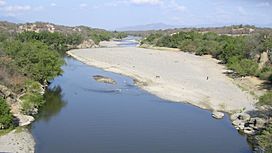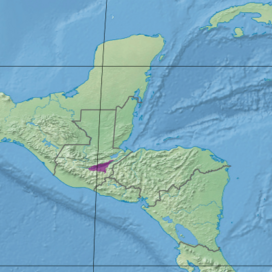Motagua Valley thornscrub facts for kids
Quick facts for kids Motagua Valley thornscrub |
|
|---|---|

|
|

Ecoregion territory (in purple)
|
|
| Ecology | |
| Biome | Deserts and xeric shrublands |
| Borders | Central American Atlantic moist forests, Central American montane forests and Central American pine–oak forests |
| Geography | |
| Area | 2,330 km2 (900 sq mi) |
| Country | Guatemala |
| Coordinates | 14°57′N 89°39′W / 14.95°N 89.65°W |
| Conservation | |
| Conservation status | Critical/Endangered |
| Protected | 2.5%% |
The Motagua Valley thornscrub is a unique natural area, also called an ecoregion. You can find it in the Motagua River valley in eastern Guatemala. This valley is very dry because tall mountains surround it. These mountains block most of the rain.
Because it gets so little rain, the valley has special thorny plants. It's one of the driest places in Central America. This ecoregion covers about 2,330 square kilometers. It's part of the deserts and xeric shrublands biome, which means it's a dry area with many shrubs.
Contents
Where is the Motagua Valley Thornscrub?
The Motagua Valley is known as one of the driest spots in Central America. It is surrounded by impressive mountains. To the north, you'll find the Sierra de las Minas. These mountains can reach heights of up to 3,000 meters (about 9,800 feet).
To the south, there's the Sierra del Merendón. These mountains are also tall, reaching over 2,000 meters (about 6,500 feet). The dry climate here is very different from the wet cloud forests found higher up in these nearby mountains.
What is the Climate Like?
The climate in the Motagua Valley thornscrub is called a Tropical savanna climate - dry winter. This is also known as a Köppen climate type "Aw". This type of climate means the temperatures stay pretty much the same all year. However, it has a very clear dry season.
During the driest month, there is less than 60 millimeters (about 2.4 inches) of rain. This is much less than the average amount of rain for other months. Temperatures in the valley can get very hot, sometimes reaching up to 50 °C (122 °F). The area receives less than 500 mm (about 20 inches) of rain each year.
Plants and Animals of the Motagua Valley
The plants in this ecoregion are mostly thorny species. You'll see many types of cactus, especially from the genus Opuntia. There are also acacia trees and other thorny bushes. Many of these thorny bushes belong to the Fabaceae family, which includes peas and beans.
Along the river valleys, where there is always water, you'll find different plants. These areas have lush forests right next to the river.
Amazing Animals of the Thornscrub
The Motagua Valley thornscrub is home to 75 different kinds of birds. Many of these are Columbidae (like doves), Tyrannidae (flycatchers), Icteridae (like orioles), and Fringillidae (finches). This ecoregion is also the only place in Central America where the Momotus mexicanus bird lives.
The valley is also home to several types of lizards that are in danger. One is the Guatemalan Spiny-tailed Iguana (Ctenosaura palearis). Another is the Motagua Valley beaded lizard (Heloderma charlesbogerti). This beaded lizard is one of the most endangered lizards in the world. It is also endemic to this ecoregion, meaning it lives nowhere else on Earth.
Protecting the Motagua Valley
There are not many protected areas in the Motagua Valley thornscrub. The ecoregion is greatly affected by the growth of farming that uses irrigation. This type of farming is the main reason why this special area is being destroyed so quickly.
Only about 2.53% of the ecoregion is protected. These protected areas include a part of Cerro Miramundo National Park. There are also a few regional municipal parks and private nature reserves.
See also
 In Spanish: Matorral espinoso del valle del Motagua para niños
In Spanish: Matorral espinoso del valle del Motagua para niños

